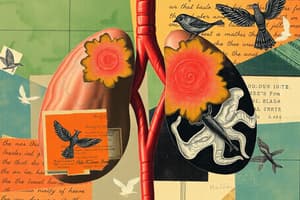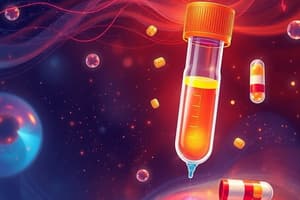Podcast
Questions and Answers
What is the primary function of insulin in the body?
What is the primary function of insulin in the body?
What triggers the secretion of glucagon from the pancreas?
What triggers the secretion of glucagon from the pancreas?
How does glucagon affect blood sugar levels?
How does glucagon affect blood sugar levels?
Which cells in the pancreas produce insulin?
Which cells in the pancreas produce insulin?
Signup and view all the answers
What physiological effect does insulin have on blood sugar?
What physiological effect does insulin have on blood sugar?
Signup and view all the answers
What happens to glucose in the blood when there is insufficient insulin production?
What happens to glucose in the blood when there is insufficient insulin production?
Signup and view all the answers
What is the effect of glucagon on glycogen in the liver?
What is the effect of glucagon on glycogen in the liver?
Signup and view all the answers
How do insulin and glucagon work together in the body's energy regulation?
How do insulin and glucagon work together in the body's energy regulation?
Signup and view all the answers
What is the primary function of insulin in glucose metabolism?
What is the primary function of insulin in glucose metabolism?
Signup and view all the answers
What condition is indicated by a serum glucose level greater than 7 mmol/L?
What condition is indicated by a serum glucose level greater than 7 mmol/L?
Signup and view all the answers
Which of the following is a common symptom of hyperglycemia?
Which of the following is a common symptom of hyperglycemia?
Signup and view all the answers
In which type of diabetes is the lack of insulin production typically observed?
In which type of diabetes is the lack of insulin production typically observed?
Signup and view all the answers
What is the main purpose of the process of glycogenesis?
What is the main purpose of the process of glycogenesis?
Signup and view all the answers
What test measures blood sugar levels after fasting for at least 8 hours to diagnose diabetes?
What test measures blood sugar levels after fasting for at least 8 hours to diagnose diabetes?
Signup and view all the answers
What happens to excess glucose that is not immediately needed by the body?
What happens to excess glucose that is not immediately needed by the body?
Signup and view all the answers
What is the term for the process of converting glycogen back into glucose?
What is the term for the process of converting glycogen back into glucose?
Signup and view all the answers
Which of the following is NOT a criterion for diagnosing diabetes?
Which of the following is NOT a criterion for diagnosing diabetes?
Signup and view all the answers
What is a common complication associated with poorly managed diabetes?
What is a common complication associated with poorly managed diabetes?
Signup and view all the answers
What is the main purpose of using a sliding scale for insulin administration?
What is the main purpose of using a sliding scale for insulin administration?
Signup and view all the answers
Which of the following symptoms is an early sign of hypoglycemia?
Which of the following symptoms is an early sign of hypoglycemia?
Signup and view all the answers
What is the first step in treating mild hypoglycemia?
What is the first step in treating mild hypoglycemia?
Signup and view all the answers
What does Metformin primarily do to lower blood sugar levels?
What does Metformin primarily do to lower blood sugar levels?
Signup and view all the answers
When is Metformin contraindicated for use?
When is Metformin contraindicated for use?
Signup and view all the answers
What is a common side effect of the medication Gliclazide?
What is a common side effect of the medication Gliclazide?
Signup and view all the answers
In the case of severe hypoglycemia where the patient is unconscious, which treatment is appropriate?
In the case of severe hypoglycemia where the patient is unconscious, which treatment is appropriate?
Signup and view all the answers
Which of the following best describes the basal-bolus method of insulin therapy?
Which of the following best describes the basal-bolus method of insulin therapy?
Signup and view all the answers
What is the primary role of lifestyle changes in managing Type 2 Diabetes?
What is the primary role of lifestyle changes in managing Type 2 Diabetes?
Signup and view all the answers
Why should Metformin be stopped before a radiology test using contrast dye?
Why should Metformin be stopped before a radiology test using contrast dye?
Signup and view all the answers
What is a significant nursing implication when administering insulin?
What is a significant nursing implication when administering insulin?
Signup and view all the answers
What is a common implication of prolonged hypoglycemia if not treated promptly?
What is a common implication of prolonged hypoglycemia if not treated promptly?
Signup and view all the answers
What should a patient understand about self-administration of insulin?
What should a patient understand about self-administration of insulin?
Signup and view all the answers
What is the primary cause of the Hyperosmolar Hyperglycemic State (HHS) in type 2 diabetes?
What is the primary cause of the Hyperosmolar Hyperglycemic State (HHS) in type 2 diabetes?
Signup and view all the answers
Which combination best describes the insulin dosing strategy for hospitalized patients using a sliding scale?
Which combination best describes the insulin dosing strategy for hospitalized patients using a sliding scale?
Signup and view all the answers
Which of the following statements accurately portrays the use of basal-bolus dosing?
Which of the following statements accurately portrays the use of basal-bolus dosing?
Signup and view all the answers
What is a recommended glycemic goal for HbA1c in diabetic patients?
What is a recommended glycemic goal for HbA1c in diabetic patients?
Signup and view all the answers
What role does insulin play in the body's metabolism?
What role does insulin play in the body's metabolism?
Signup and view all the answers
Which type of insulin has no peak effect, maintaining a constant level in the body?
Which type of insulin has no peak effect, maintaining a constant level in the body?
Signup and view all the answers
What is one major disadvantage of using a sliding scale for insulin delivery?
What is one major disadvantage of using a sliding scale for insulin delivery?
Signup and view all the answers
What is a significant characteristic of type 2 diabetes at the cellular level?
What is a significant characteristic of type 2 diabetes at the cellular level?
Signup and view all the answers
Which of the following treatments is always required for Type 1 Diabetes Mellitus (T1DM)?
Which of the following treatments is always required for Type 1 Diabetes Mellitus (T1DM)?
Signup and view all the answers
What metabolic condition includes obesity and hypertension as risk factors for developing type 2 diabetes?
What metabolic condition includes obesity and hypertension as risk factors for developing type 2 diabetes?
Signup and view all the answers
Which of the following illustrates a characteristic of rapid-acting insulin?
Which of the following illustrates a characteristic of rapid-acting insulin?
Signup and view all the answers
What is the recommended fasting blood glucose goal for diabetic patients?
What is the recommended fasting blood glucose goal for diabetic patients?
Signup and view all the answers
Which of the following is a minimal treatment for managing type 2 diabetes, aside from insulin?
Which of the following is a minimal treatment for managing type 2 diabetes, aside from insulin?
Signup and view all the answers
What is a possible long-term consequence of poorly managed diabetes?
What is a possible long-term consequence of poorly managed diabetes?
Signup and view all the answers
Study Notes
Pancreas & Glucose Regulation
- The pancreas plays a crucial role in glucose regulation through the production of insulin and glucagon.
- Insulin lowers blood sugar levels by facilitating glucose uptake into cells for energy.
- Glucagon raises blood sugar levels by stimulating the liver to release stored glucose.
- These hormones work in tandem to maintain glucose homeostasis, ensuring stable blood sugar levels.
Diabetes Overview
- Diabetes is a metabolic disorder characterized by hyperglycemia, resulting from either insufficient insulin production, impaired insulin action, or both.
- Excess glucose is stored as glycogen in the liver (short-term) and as triglycerides in adipose tissue (long-term).
- When blood glucose levels fall, glucagon stimulates glycogenolysis, breaking down glycogen into glucose.
- Without insulin, blood glucose levels rise as cells cannot properly utilize glucose.
Diagnosis of Diabetes
- Diabetes is diagnosed based on fasting blood glucose levels, A1c levels, oral glucose tolerance test results, or random blood glucose levels.
- Fasting blood glucose > 7 mmol/L.
- A1c > 6.5%.
- OGTT: Blood sugar > 11.1 mmol/L two hours after a sugary drink.
- Random blood sugar > 11.1 mmol/L.
Types of Diabetes
- Type 1 diabetes: characterized by a lack of insulin production due to autoimmune destruction of beta cells.
- Type 2 diabetes: the most common type, caused by insulin resistance and/or a deficiency in insulin production.
- Gestational diabetes: develops during pregnancy and typically resolves after delivery.
Signs & Symptoms of Diabetes
-
Hyperglycemia:
- Polyuria (increased urination)
- Polydipsia (increased thirst)
- Polyphagia (increased hunger)
- Glucosuria (glucose in urine)
- Weight loss
- Fatigue
-
Hypoglycemia:
- Shakiness
- Sweating
- Hunger
- Dizziness
- Confusion
- Seizures
- Coma
Complications of Diabetes
- Macrovascular: heart disease, stroke, peripheral artery disease, leading to amputations
-
Microvascular:
- Retinopathy: retinal damage causing vision loss
- Neuropathy: nerve damage
- Nephropathy: chronic kidney failure
Type 1 Diabetes
- Previously known as juvenile onset diabetes or insulin-dependent diabetes.
- Requires exogenous insulin therapy for life.
- Diabetic Ketoacidosis (DKA): a severe complication characterized by hyperglycemia, ketones in the blood and urine, dehydration, and electrolyte imbalances.
Type 2 Diabetes
- Previously known as adult-onset diabetes or non-insulin-dependent diabetes.
- May be managed with lifestyle modifications, oral medications, or insulin therapy.
- Hyperosmolar Hyperglycemic (Nonketotic) State (HHS/HHNS): a severe complication characterized by extreme hyperglycemia, dehydration, and electrolyte imbalances.
Treatment of Diabetes
- Type 1 diabetes: insulin therapy
-
Type 2 diabetes:
- Lifestyle modifications: weight loss, healthy diet, regular exercise, smoking cessation, reduced alcohol consumption
- Oral medications: metformin, sulfonylureas, etc.
- Insulin therapy: if lifestyle modifications and oral medications are insufficient to control blood glucose.
Glycemic Goal of Treatment
- HbA1c < 7%
- Fasting blood glucose: 4 to 7 mmol/L
- 2-hour postprandial glucose: 5 to 10 mmol/L
Insulin: Key Functions and Goals
- Helps diabetic patients utilize carbohydrates, fats, and proteins for energy.
- Facilitates glucose storage in the liver as glycogen.
- Converts excess glycogen into fat for long-term energy storage.
- Made from human insulin using recombinant DNA technology.
- Goal: regulate hyperglycemia and reduce diabetes-related complications.
Types of Insulin
-
Rapid-acting:*
- Onset: 10-15 minutes
- Peak: 1-2 hours
- Duration: 3-5 hours
- Examples: lispro (Humalog), aspart (NovoRapid)
-
Short-acting:*
- Onset: 30 minutes
- Peak: 2-3 hours
- Duration: 6 hours
- Example: regular insulin (Humulin R)
-
Intermediate-acting:*
- Onset: 1-3 hours
- Peak: 4-10 hours
- Duration: 12-18 hours
- Example: insulin isophane suspension aka NPH (Humulin N)
-
Long-acting:*
- Onset: 90 minutes
- Peak: No distinct peak
- Duration: 24 hours
- Example: insulin glargine (Lantus, Basaglar)
Insulin Fixed Combinations
- Contain two different insulins: one intermediate-acting and one rapid-acting or short-acting.
- Mimic natural insulin production in healthy individuals.
- Examples: Humulin 30/70, Novolin 30/70, 40/60, 50/50
Insulin Sliding Scale Dosing
- Used for hospitalized patients with fluctuating blood sugar levels.
- Insulin doses are adjusted based on point-of-care blood sugar tests.
- Faster-acting insulin (lispro, aspart) or short-acting (regular) insulin is administered subcutaneously.
- Disadvantages:
- Delays treatment of high blood sugar levels, leading to significant blood sugar fluctuations.
- Not considered the preferred method for long-term diabetes management.
Basal-Bolus Dosing
- The preferred method for managing insulin as it mimics the natural pancreas function.
-
- Basal insulin (long-acting): provides a steady level of insulin throughout the day. Example: Lantus (insulin glargine) once daily, typically at bedtime.
- Bolus insulin (rapid-acting): covers the rise in blood sugar after meals. Example: Novorapid (insulin aspart) before each meal.
- Correction doses (optional): extra insulin added if blood sugar levels are high based on a sliding scale.
Hypoglycemia
- Most common side effect of insulin therapy.
- Occurs when blood sugar drops below 4 mmol/L.
- Treatment:
- Mild cases: consume protein and reduce carbohydrates.
- Severe cases:
- Glucose by mouth (juice, dextrose tablets, gel) if conscious.
- IV D50W or IM glucagon if unconscious.
Oral Antihyperglycemic Drugs
Metformin (Biguanide)
- First-line medication for type 2 diabetes.
- Mechanism of Action:
- Decreases hepatic glucose production (suppresses glycogenolysis).
- Reduces intestinal glucose absorption.
- Improves insulin sensitivity.
- Contraindications:
- Kidney disease (creatinine clearance < 30 mL/min).
- Type 1 diabetes.
- Adverse Effects:
- Gastrointestinal disturbances (bloating, nausea, cramping, fullness, diarrhea).
- Interactions:
- Contrast media: Metformin can cause acute kidney injury when used with iodinated contrast dye for radiology tests.
- Discontinue Metformin 24-48 hours before contrast media administration.
Gliclazide (Sulfonylurea)
- Mechanism of Action:
- Stimulates insulin release from beta cells by binding to specific receptors.
- Indications:
- Used as second-line therapy for patients with inadequate blood sugar control on metformin alone.
- Adverse Effects:
- Hypoglycemia.
- Weight gain.
- Nausea and heartburn.
Diabetic Drug Nursing Implications
- Document: Patient history, vital signs, blood glucose levels, and A1c.
- Assess: Patient's ability to eat to avoid hypoglycemia, potential for nausea or vomiting.
- NPO Status: Consult with the provider regarding antidiabetic therapy orders for patients who are NPO (nothing by mouth).
- Concerns: Monitor for increased risk of hyperglycemia during stress, pregnancy, infection, or illness.
- Patient Education: Explain the disease, diet and exercise guidelines, self-administration of meds, and potential complications.
- Double-check insulin and other medications due to high-risk potential.
- Blood Glucose Monitoring: Measure blood glucose before administering insulin (typically 30 minutes before meals).
- Insulin Storage: Ensure proper storage conditions for insulin vials.
- IV Insulin Administration: Use only insulin syringes. Humulin R is the only insulin approved for IV use.
- Mixing Insulin: Follow the "clear then cloudy" rule (rapid-acting then intermediate-acting).
- Insulin Injection Sites: Rotate sites to prevent lipodystrophy.
- Discharge Instructions: Provide patient education on self-administration of insulin before discharge.
- Metformin: Administer with food to reduce GI effects. Discontinue before procedures requiring contrast dye.
- HbA1c Monitoring: Assess long-term compliance with diet and medication therapy.
Studying That Suits You
Use AI to generate personalized quizzes and flashcards to suit your learning preferences.




